Orthodontics without extraction
Dentysta stomatolog Warszawa Ursynów ADENTIS / Services / Orthodontics without extraction
What is malocclusion? |
Malocclusion is the incorrect positioning of teeth in the dental arches, commonly known as “crooked teeth”, but also situations in which the teeth are “straight” but the dental arches close together. in an incorrect way, e.g. the upper teeth are significantly forward compared to the lower ones. Such an incorrect arrangement of the upper and lower dental arches may be noticeable by the patient or parents, it may be visible in facial features, but it may also go unnoticed.
If you have the above-mentioned conditions, please contact Adentis for appropriate diagnosis.
The first visit is a consultation visit, during which the doctor conducts a preliminary examination and interview.
Features of a proper smile
 |
 |
 |
 |
| A narrow jaw causes black triangles when smiling. | After orthodontic treatment – full smile. |
The bite affects the patient’s overall health.
Orthodontic treatment is often the only option to restore overall health and preserve teeth, not just an aesthetic move.
The muscles of the face and skull must be in balance, if the bone structures are shifted in the skull, they adapt to the incorrect positioning of the jaw in relation to the skull, then the teeth adjust to this condition, they also adapt to the incorrect positioning of the jaw bone to the lower jaw . Therefore, in the first stage of orthodontic treatment, orthodontic treatment should be carried out, i.e. setting the jaw and mandible in the correct relationship, and then orthodontic treatment, i.e. setting the teeth. If the treatment is based only on straightening crooked teeth, the effects of such treatment are unstable and the malocclusion will still destroy the teeth, the temporomandibular joint, cause gum recession and tooth breakage because the cause of the misalignment of the teeth has remained unchanged
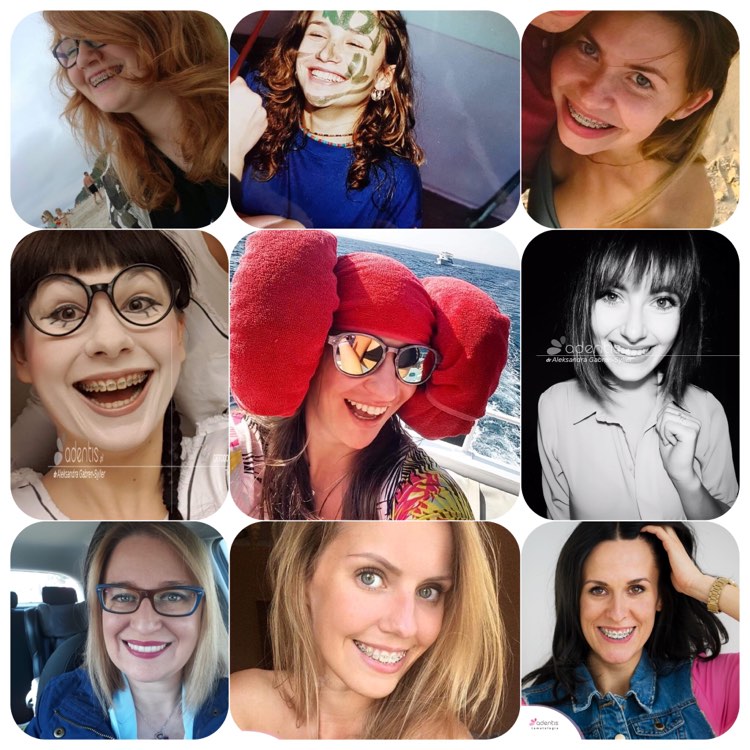
Dr Aleksandra Gabren deals with
prevention and treatmentof malocclusions in children, adolescents and adults.

Incorrect position of the tongue may be one of the causes of malocclusion.

Orthodontic treatment eliminates:
- pain related to temporomandibular joint dysfunction (tinnitus),
- headache
- sound symptoms in the jaw joint disappear,
- spine pain,
- fatigue during the day
- restores the correct breathing pattern (clears the respiratory tract),
- improvement of well-being,
- improves sleep,
- improves appearance and well-being, delays facial aging, improves pronunciation and improves oral hygiene,
- correcting dental irregularities is sometimes the only condition to preserve teeth, because malocclusion due to poor alignment of teeth may lead to their destruction, abrasion, loosening and, consequently, their loss.
Insertion into the tooth arch without extraction.

Malocclusion is the incorrect position of the jaw to thejaw.
Orthodontic treatment is undertaken to eliminate:
- tooth crowding,
- grinding and clenching of teeth,
- excessive and inappropriate tooth abrasion,
- excessive tartar build-up
- exposure of tooth necks
- unsatisfactory cosmetics (crowding, gaps, rotations, too deep and/or too shallow bite of the upper teeth on the lower ones, reverse overbite of the front teeth, i.e. the lower teeth are in front of the upper ones)
- loose teeth due to periodontal disease (periodontal loosening of teeth)
- difficulties in replacing missing teeth with prosthetic restorations due to the unfavorable position of the remaining teeth in the oral cavity.



To provide a full diagnosis, diagnostic impressions are taken, the doctor orders X-rays (pantomographic and cephalometric).
The models are mounted in the articulator in the neuromuscular position and a treatment plan is presented on this basis. Diagnostic models are made to assess the correctness of the structure of dental arches, they are analyzed, the teeth and their spacing are measured.
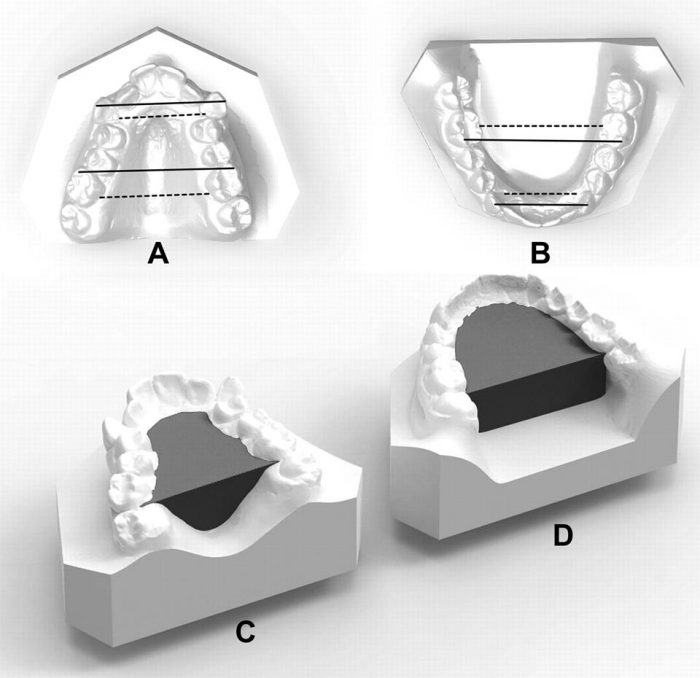
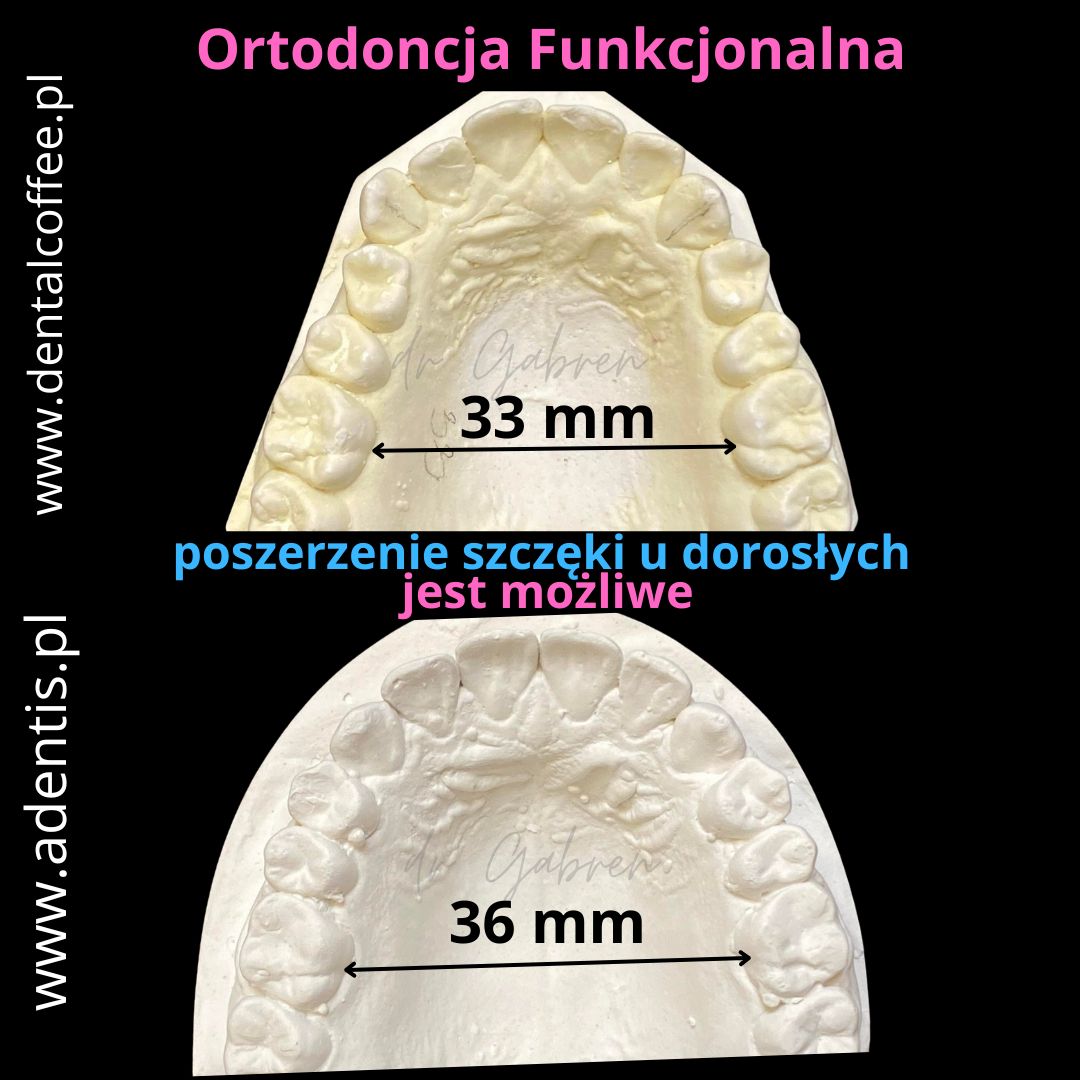
Improper position of the maxilla to the mandible
The jaw is pushed back, which occurs, among others, if the jaw is too short or too narrow, it causes narrowing of the respiratory tract, which affects the brain’s hypoxia and has many side effects (fainting, breathing difficulties, upper respiratory tract infections, headaches, migraines, tinnitus ears).
Width expansion of the maxilla and mandible
The correct shape of the dental arch of the maxilla and mandible should be U-shaped (Gothic arch).
Maxilla and mandible



For orthodontic treatment to be successful, additional braces are often necessary (not very comfortable for the patient in the initial period). Thanks to such devices, it is possible to precisely influence the position of the molars, which are crucial for maintaining a stable result of orthodontic treatment and minimizing the possibility of recurrence.
Asymmetries in the skull cause spine pain, headaches, tooth displacement, malocclusion.
Straightening the teeth is not the most important thing, but restoring balance and symmetry in the skull.
Only then should you start straightening your teeth.
 |
 |
 |
 |
Esthetic rehabilitation. Mauro Fradeani
Dental abnormalities deform the facial bones.

Esthetic rehabilitation. Mauro Fradeani
Retention treatment.
After orthodontic and orthopedic treatment, there is a retention treatment phase. To prevent the defect from recurring, the patient wears retention appliances. Malocclusion may recur despite such treatment when the facial muscles are not in balance. Because when we remove braces, the muscles will dictate the final position of the teeth. The main factor is not muscle strength but the duration of this force. If we do not have balanced muscles, all the abnormalities from before treatment will recur.

It is necessary to restore correct body posture (pelvic stabilization), correct swallowing ( tongue work) – this is what speech therapists deal with, correct nasal breathing (removal of fungus from the body, exercises to strengthen the orbicularis muscle of the mouth)
That is why muscle rehabilitation during orthodontic treatment is so important. Rebuilding of grass muscles takes about 8 months. At Centrum Adentis, Maciej Iwanowsk, M.A. in physiotherapy, works with the patient to restore the proper function of the entire body.
Classification of malocclusion

Control visits with fixed orthodontic appliances take place every 4-6 weeks.
HYGIENEDuring orthodontic treatment, it is extremely important to follow hygiene rules – brackets and rings promote the deposition of dental plaque, which increases the risk of caries.
We recommend using irrigators for interdental spaces. Such an investment from the beginning of wearing braces helps a lot in maintaining proper oral hygiene.
Request an orthodontic consultation with your child aged 5-6.
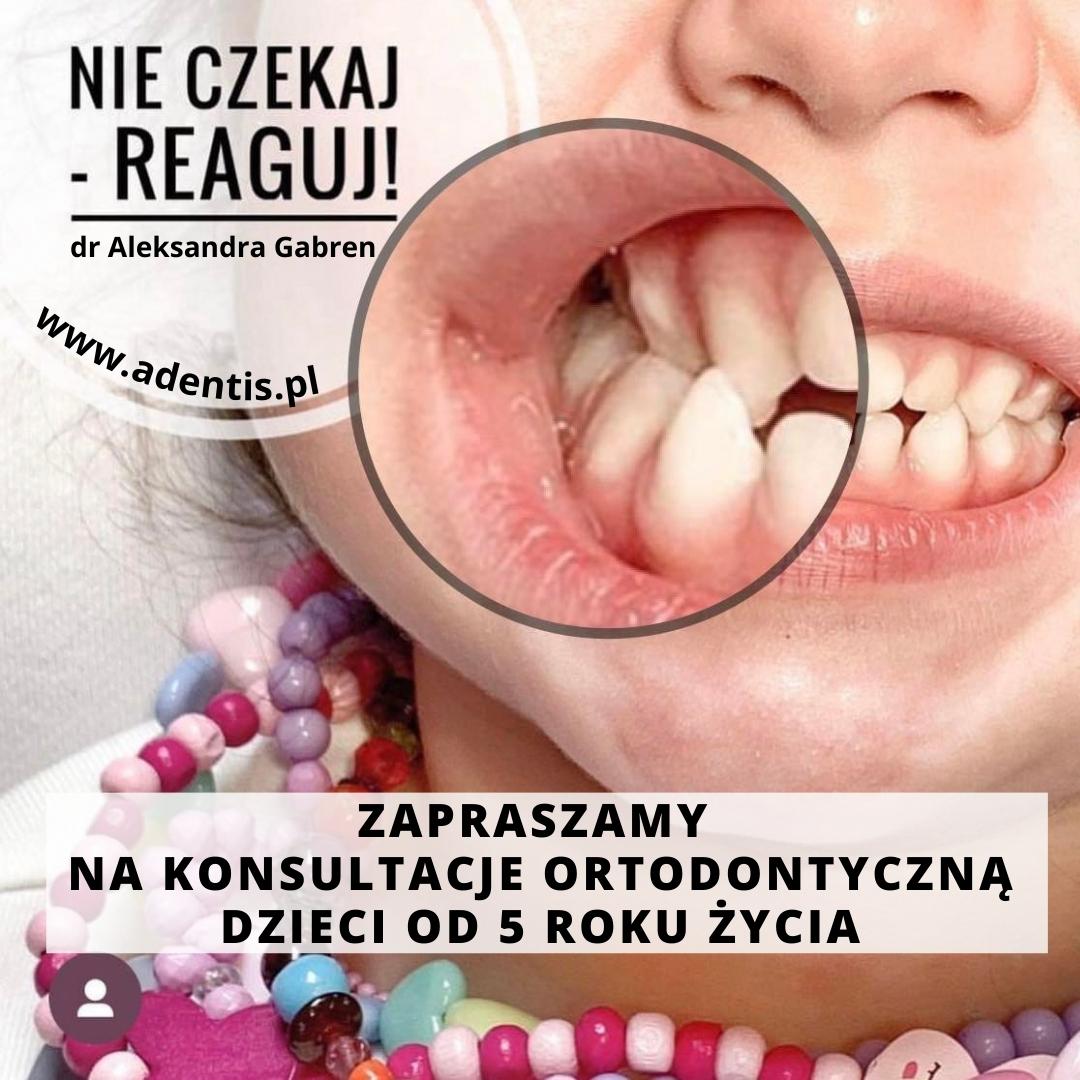
If a malocclusion has occurred and thechild already has its first permanent teeth in its mouth and is at the appropriate age, the orthodontist starts treatment with a removable brace. Treatment with removable braces most often takes place until the baby teeth are replaced with steles, i.e. from 4 to 12 years of age. It is an individually made appliance for a given child and requires taking “measurements”, i.e. impressions of the teeth. Removable braces are very effective in childhood, especially in correcting the alignment of both dental arches, improving facial features, and correcting abnormal tilt or tilt of teeth. Provided that removable braces are worn for a minimum of 4 hours during the day and all night (contrary to the common belief that they are “braces only for night”). The duration of orthodontic treatment depends on the malocclusion, age and, very importantly, on the systematic and disciplined use of the brace. Follow-up visits with removable braces take place every 6 weeks.
Unfortunately, malocclusion (except the really small ones) is not only an aesthetic problem. Crooked teeth make it difficult to thoroughly clean the teeth and thus promote the deposition of plaque and tartar, which are the main cause of gum inflammation and the resulting complications. An incorrect arrangement of the dental arches may cause a disturbed facial profile, poor positioning of the lips, and in addition to these aesthetic effects, it also causes uneven load on the teeth, excessive wear (abrasion), biting of the gums and its damage, ineffective biting and chewing, and incorrect positioning of the tongue. If this condition persists for many years, it leads to spontaneous tooth movement and deterioration of their alignment.
Persistent malocclusion may lead to pathological tooth wear and problems with the temporomandibular joint.
It affects facial asymmetry, causes changes in the spine and many others.
Face maskis used to protrude a retracted jaw.
The face mask is used to treat patients with insufficient jaw development (the jaw is retracted in relation to the entire face and skull). An orthodontic face mask is an external traction used to treat anterior defects, which have their etiology due to deficient jaw growth. You can connect the mask to braces, directly to the teeth or to an orthodontic implant.
 |
 |
When to see an orthodontist?
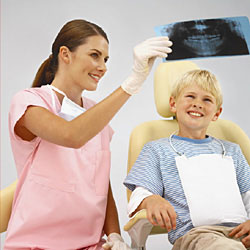 < /p>
< /p>
Around the age of three, when the child has already erupted all its milk teeth. If the orthodontist does not find any malocclusion disorders, the next visit should take place when the child has four permanent upper and lower incisors (the so-called first and second incisors), i.e. around the age of eight.
Can parents somehow prevent malocclusion in a child?
Yes, because they are usually acquired. The cause of malocclusion may be, for example, sucking a pacifier, so it should be limited to a minimum. Giving your toddler only semi-liquid foods is also to blame. Meanwhile, your toddler should also eat products that need to be chewed well (bread with crust or apple). Thanks to such “gymnastics”, the jaws will develop well and permanent teeth will fit in them.
Is it true that tooth decay can cause a bad bite?
There is still a belief that there is no need to take care of baby teeth because they will fall out anyway. It’s wrong! If left untreated, caries may lead to inflammation of the tissues surrounding the tooth. Tissue inflammation may result in damage to the permanent tooth buds. Another consequence is the premature loss of baby teeth. This adversely affects the development of the jaw bones and may lead to incorrect positioning of permanent teeth. Therefore, let’s take care of the child’s oral hygiene – let’s brush his teeth and teach him how to do it – and when he turns one year old, let’s go for a check-up visit to the dentist.
And if an orthodontist finds a malocclusion in a child, how can he or she be helped?
Malocclusion in children between 4 and 12 years of age can be corrected with removable braces. Removable appliances develop, for example, the bones of the jaw and mandible, and also influence the proper functioning of the muscles surrounding the oral cavity, thanks to which all permanent teeth can erupt. Removable braces are not permanently attached to the teeth, so you need to make sure that your child wears them at night and for 6-8 hours during the day. You must not take breaks of several days, because orthodontic treatment will not be effective.
This is a type of brace that the patient can remove on his own. The removable brace is worn according to the doctor’s instructions, usually for about a dozen or so hours a day. A removable orthodontic appliance may contain additional elements such as 1. – screw, 2. – spring.
Contrary to popular belief among patients, there are no age restrictions for orthodontic treatment.
Caring parents who would like an orthodontist to preventively check their child’s bite should definitely come to the orthodontist when the 6-7-year-old has already erupted the first permanent molars and the upper and lower incisors. Also when the child’s peers have been able to boast about these teeth for a long time, and our child’s milk teeth are still firmly embedded in the bones.
Orthodontic treatment may vary depending on the patient’s age. There are different possibilities when the patient is still in the period of growth and development, and different when he is already an adult.
Malocclusion can often go unnoticed unless it obviously changes facial features. Therefore, it is worth consulting a specialist orthodontist, especially when the following symptoms and behaviors are observed:
– in children and adolescents:
- breathing through the nose
- harmful habits, e.g. biting nails, pencils, finger sucking, pacifier sucking
- facial symmetry disorders
- too early loss of primary teeth (e.g. removed due to caries)
- deciduous teeth fall out too late
- teeth erupted in the wrong place
- retracted or protruding jaws, “chin”
- improper arrangement of teeth (crowding or gaps)
- biting the upper teeth into the lower teeth too deep or too shallow
- reverse overbite of the front teeth, i.e. the lower teeth are in front of the upper teeth)


